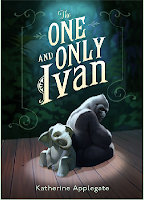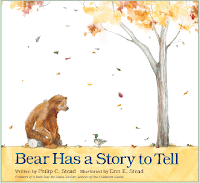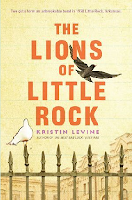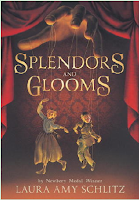Caldecott Reviews:
Oh, no! by Candace Fleming & Illustrated by Eric Rohmann
Oh, no! is the story of a frog that falls into a deep hole and needs help getting out. One by one a mouse, a loris, a sun bear, and a monkey try to help but fall into the hole calling out “Oh, no!” as they fall. Once all five animals are trapped a hungry tiger appears offering to help; with a shout all five yell, “Oh, no!” and an elephant charges to the rescue pulling all five out as the tiger falls in. The story is designed to be read aloud with a rhythmic beat and opportunities for the audience to shout out, “Oh, no!”.
The illustrations are created with an earth tone palette of browns, tans, and greens. While the colors are dark, the characters appear to pop off the page. Without the illustrations the text is weak. While the text tells a straightforward and repetitive story, the illustrations tell a secondary story of a tiger stalking his prey. Throughout the book you can catch glimpses of the tiger’s tail and paws until he appears fully on the page with his offer to help while licking his teeth. The illustrations make this story.
And then it's spring by Julie Fogliano & Illustrated by Erin E. Stead

After a snowy winter, a young boy and his dog go outside and observe all the brown the surrounds them and decide to plant a garden. The boy and his dog wait and worry until the brown becomes a hum of green and at last the brown is gone and green is all around.
Fogliano’s story is a simple poem about the brief weeks between the melting away of winter and the green of spring. Her story shows what great satisfaction there can be in patience. What takes Fogliano’s story from a simple, sweet poem to a great picture book are Stead’s illustrations. Stead’s illustrations add depth and understanding to the story. The boy’s impatience is reflected in the illustrations and readers can empathize with his desire to see signs of spring. This is a great picture book for nonreaders. The text is not necessary to enjoy the book and with the details Stead incorporates in her illustrations, children can make up their own stories.
Newbery Reviews:
Kelper's dream by Juliet Bell
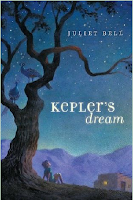
Eleven year old, Ella is forced to spend the summer with the grandmother she never met. Her mother has been hospitalized to undergo a dangerous cancer treatment in hopes of curing her of leukemia. Ella’s parents are divorced and her dad cannot be pulled away from his job running fishing expeditions to take care of her and suggests his mother look after her. With no other option she is sent from California to Albuquerque, New Mexico. When she arrives she is greeted by Miguel, the caretaker for her grandmother’s estate, who is a pleasant man with a daughter about Ella’s age. This is the only ray of light in her dark summer ahead. To Ella, it appears that the only things her grandmother, Violet, cares about are books, grammar, and etiquette. Violet is a collector of rare books and her house it littered with them. At the center of her house is a massive library packed with books. There is one in particular that is the prize of her collection “Kepler’s dream of the moon.” She purchased this book in honor of her deceased husband, a passionate astronomer. When the book is stolen from the library Ella teams up with Miguel’s daughter, Rose, to find it. Rose wants to find the book because she is worried her father will be blamed for its theft. Ella wants to find the book in hopes of repairing her fractured family. Ella discovers that this book is at the heart of the story that broke her family apart.
Kepler’s dream is a quiet novel with well-developed characters. At first you believe it is a mystery but as you read the book, you discover that the story is really about family, both the loss and gain of family. Ella’s father has been absent the majority of her life and with the possibility of her mother dying, her father’s behavior towards her does not change. Her grandmother is cold towards Ella’s father and makes little reference to her mother. If her mother dies, Ella believes she will be alone. This story is slow-paced. While adults will love what this book has to offer children, younger readers may have a difficult time moving through the book, which has an abundance of character introductions that are brief and sometimes confusing to keep track of.
Bomb: the race to build-and-steal the world's most dangerous weapon by Steve Sheinkin
Harry Gold has the F.B.I. banging on his front door. In a panic he tries to destroy seventeen years of evidence, but as the F.B.I. enters his room they find everything they need to prove Harry Gold was a Soviet spy. This is how Sheinkin begins his story of the atomic bomb. From here we go back in time from 1950 to 1934, where it all started. Bomb is the story of betrayal, espionage, war, and science; weaving together the history of the race to build the first atomic bomb, World War II, and the efforts of Germany, the Soviet Union, and the United States to stop each other from being first.
This work of nonfiction reads like an Alex Rider novel; with vivid writing and first person quotes. Sheinkin 's movement through time and place is fluid and engaging, encouraging readers young and old to keep reading and see who betrays who next. The story does not fully examine the history of the time period but does appeal to young readers, opening the door for further exploration. This is a great book for both lovers of fiction and nonfiction.
Mighty Miss Malone by Christopher Paul Curtis

Deza Malone is a strong twelve year old girl growing up in Gary, Indiana. She takes great pride in her education and family. Both Deza's parents and teacher have big ambitions for Deza's future but with the backdrop of the Great Depression, Deza has to hold tight to her dreams. Deza's father has been out of work for a longtime, like most colored men in Gary. Her father decides to move to Flint, Michigan to find work then send for his family. After a month goes by with no word from her father, things get worse. Deza's mother losses her job. Deza, her older brother Jimmie, and her mother pack there things and head to Flint hoping to stay with Deza's grandmother, find her father, and find a job for her mother. But things do not workout as planned and they end up in Hooverville, outside of Flint. From there Jimmie decides to leave, hoping to use his beautiful singing voice to become a performer, leaving Deza and her mother behind to find her father.
Deza's story has many twists and turns. As Deza's story moves forward readers are shown the devastation of the Great Depression. While the story changes directions several times, Deza is a great storyteller with a likeable attitude towards her circumstances, giving readers hope. For older readers, the ending may resolve to easily, but younger readers will enjoy Deza's happily ever after.
Printz Reviews:
The list by Siobhan Vivian
Every year at Mount Washington High School a new list is posted naming the ugliest and prettiest girl in each grade. This list is released one week before the Homecoming Dance.
The List is told through the eyes of eight different girls. Freshman to senior, we follow the prettiest and ugliest girls in each grade, and we see how they are affected by the way others perceive them. They each receive more attention, both good and bad, and we see the consequences of how these girls are treated by their classmates. After this list is posted, several problems arise for each of the girls. The creators of the list remain anonymous, but each year when it is posted, it gives the entire student body ammunition towards the eight girls selected. The girls are now subject to bullying, jealousy, eating disorders, sibling rivalry, etc.; making their lives in high school even more stressful than normal. It is not just the “ugly” girls who are having a hard time, but the “pretty” ones as well.
This book takes us through the difficulties of figuring out who we are in high school, and how we can deal with other people’s opinions of us. The creators of the list take it upon themselves to unapologetically judge the girls on their superficial features, making each girl feel a sense of defeat. If this is how they are already perceived, then what is the point of trying? See how each girl deals with her elected label and displays her true self.
Each chapter is told through a different character. With eight characters to keep track of, the beginning chapters were a bit hard to follow. However, as the story progressed and the characters developed, it became easier to follow the different story lines and draw connections between the characters. Some of the characters were stronger than others, but with eight different girls to choose from, I found myself connecting with different girls at different points in the story. A strong aspect of this book was how it showed the fine line there is between ugly and pretty, both on the inside and outside. Although there have been many other books written about the pressures and the “mean girl” attitudes that come with surviving high school, the message of this book remains true and timeless. This book allows readers to reflect upon their own actions towards other people. I enjoyed getting to know these girls and seeing their growth through the story.
There is no dog by Meg Rosoff
What if God were a teenage boy?
Mona, a goddess with a gambling problem wins earth in a poker game. She hands the job of being God of earth to her spoiled, self-centered teenage son, Bob, in hopes of teaching him responsibility. Mr. B is assigned to be Bob's assistant. Bob is tired and lazy and leaves his assistant to clean up the mess that Bob has made of earth. Because Bob created humans in his image, the planet is filled with selfish and greedy beings. While Mr. B is trying to manage earth, God falls in love with a mortal, Lucy, an assistant zookeeper. As Bob attempts to court Lucy, strange things begin to happen. While Bob's lust for Lucy grows, the weather starts doing strange things. Mr. B and Mona warn Bob, advising him to leave the girl alone and get back to fixing earth but Bob only cares for his own desires. Through this Mr. B decides to resign and be assigned to a new planet but struggles with the guilt of leaving earth alone with Bob.
This story is told from multiple points of view. Rosoff does an amazing job of creating a believable story of a disfunctional family watching over earth. There is no dog has an ending with a twist that gives earth it's faith back.
Check back for the remaining Caldecott, Newbery, and Printz reviews.









